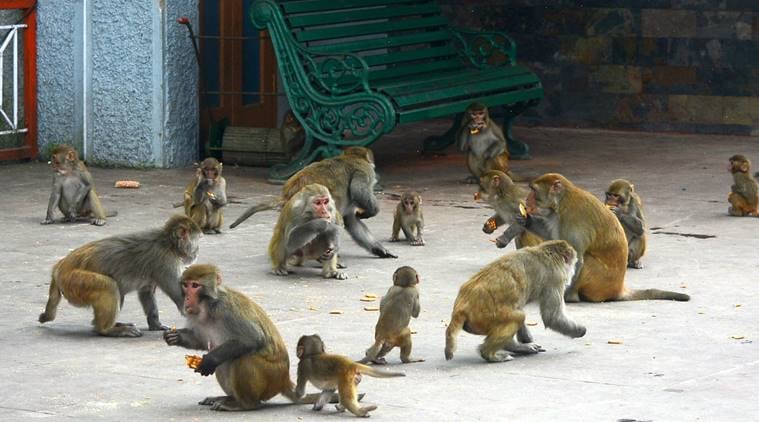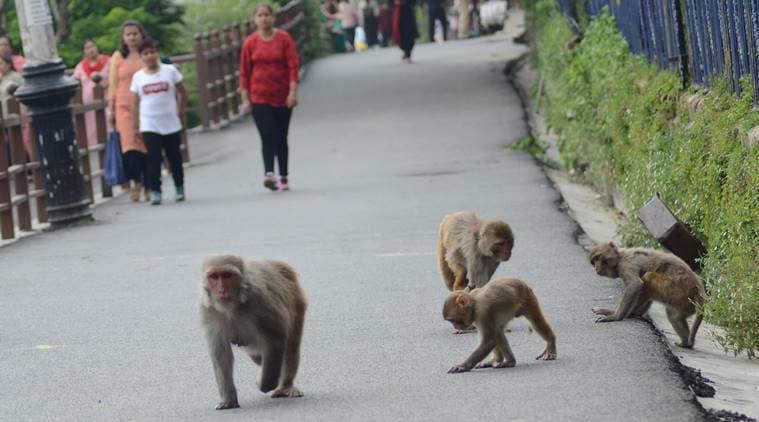 A troop of monkeys in Shimla. (Express Photo by Pradeep Kumar)
A troop of monkeys in Shimla. (Express Photo by Pradeep Kumar)
Plagued by the menace of growing population of monkeys in Shimla in 1943, the then Government of India under British rule had considered re-locating them abroad, but could not do so as a ban had been placed on their export so that they could not be used by the enemy for “nefarious purposes”.
Decades later, the menace still exists. It has been six months now since the Rhesus Macaque monkeys in Himachal Pradesh were declared vermin by the Centre in July 2019 and their culling allowed, but many residents of the state remain in a dilemma, due to religious reasons, whether to kill them or not.
Now, documents accessed by The Indian Express from the National Archives of India show that shooting monkeys had been discussed threadbare by the British way back in 1943 without any conclusive results.
The option to capture the monkeys and export them was debated and discarded as this was the time of the Second World War. “A ban has been placed on the export of monkeys during war to ensure that they may not be used for nefarious purposes by the enemy,” one file noting states.
Archival records reveal there was a fear among the British that a German plan existed to wage biological war by spreading Yellow Fever in India through the monkeys. Accordingly, the import of monkeys was also banned.
The six pages of the file, dating back to January 1943 of the then Department of Home of the Government of India, discuss various options for dealing with the problem of proliferation of monkeys in Simla (now Shimla) in particular and the then state of Punjab. The religious sentiments of Hindus played an important part in the deliberations among the government ‘babus’ back then.
 Monkeys in Shimla. (Photo by Pradeep Kumar)
Monkeys in Shimla. (Photo by Pradeep Kumar)
Titled ‘Elimination of Monkeys from Simla’, the file also has comments by officials on Mahatma Gandhi’s article in ‘Harijan’ regarding export of monkeys. Gandhi is known to have considered the export as an inhuman practice and once said that he would not send a single monkey abroad for vivisection.
Typical bureaucratic wranglings are also evident in the file notings as various officials opine on the subject, each trying to ensure that some other department takes a call on the killing of monkeys, including the then Secretary of Medical and Local Government Departments, EAR Eustace amd Secretary of the Education, Health and Lands Department, R Tottenham.
A memo by EAS Eustace to R Tottemham points out that the monkeys of Shimla have become more and more numerous and troublesome. “The creatures now constantly steal things from houses, and frighten women and children and horses in public places. The noise they make on roofs is often intolerable and the damage they do to fruit trees and gardens is known to all,” he says in a letter dated January 8, 1943 written from Lahore.
The memo ruled out transporting the monkeys from Shimla to distant places and releasing them in the wild. “Delhi Municipal Committee had engaged professional monkey catchers from Muttra (now Mathura) in the United Provinces (now Uttar Pradesh) and had deported the monkeys caught: they added however that they understood that most of the monkeys deported subsequently returned to Delhi, and that the money spent on these operations appeared to have been wasted,” he says.
It was recommended by him that shooting the monkeys was the only way of “destroying” them as poisons were avoided by them instinctively. “The langoors, the provincial government believe, give little offence, and are respected members of Simla society rather than otherwise. The main nuisance is caused by brown monkeys,” the memo notes. However, he cleverly added that the Government of India could also give observations on the issue of shooting the monkeys in view of the religious angle and objections by the “Mahants’ of the Jakhu and Kalibari temples.
However, the Home Department of the government of India felt that this was an attempt to make others take responsibility for shooting the monkeys. A file noting of R Tottemham reads, “I suspect that this is a case in which an attempt is being made to make ‘someone else’ take the responsibility for a decision and we must decline to accept the invitation. If provincial autonomy and elected local bodies mean anything, they mean that the orders of the Government of India on such a matter are not required”.
With such bureaucratic and religious history behind the decision to cull the monkeys, it is no wonder that 77 years later the progress is slow and hesitant. Monkeys are no less a menace today in Shimla than they were in 1943. Rudyard Kipling’s ‘Road-Song of the Bandar Log’, originally published in the “Jungle Book’ in 1894, aptly fits the scene today too:
Then join our leaping lines that scumfish through the pines
That rocket by where, light and high, the wild-grape swings
By the rubbish in our wake, and the noble noise we make
Be sure, be sure, we’re going to do some splendid things!